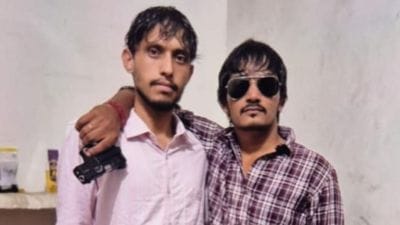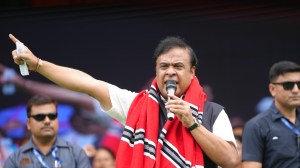Sweet Dreams Are Made of These
...

He has invested years in painstaking research, written 200-page bound scripts in shudh Hindi, sketched and painted every shot of his film on a black sheet, conducted story sessions with the stars and then… nothing.
Dr Chandraprakash Dwivedi is still best known for his Doordarshan serial Chanakya and his 2003 feature film Pinjar. But there are at least eight completed projects he isn’t known for.
The 45-year-old has traversed the entire spectrum of Indian history. After Chanakya, he started work on KM Munshi’s Patan Ni Prabhuta, an 11th century AD story about the nexus between politics and religion. He even shot an episode of it for DD, but it never went on air. Next, Dwivedi shot four episodes of a serial on the fiery Brahmin god Parshuram, in Barmer, Rajasthan. An entire Vedic village was created, and Bisleri used whenever a scene required water, as the location was 12 km away from habitation. That project was nipped when the channel and the producer had an ego tussle.
Then came Chirantan: The Eternal. Based on the Khajuraho temples, this was a love story set against the backdrop of ancient Indian erotic art. Other full-fledged projects like Ashoka, Buddha, Mohenjodaro, Krishna and Prithviraj Samyukta followed.
Sitting in his living room, Dwivedi analyses his track record. ‘‘I’ve thought about it a lot. Basically, I’ve had too many contenders to reckon with,’’ he says. He rattles off a list: When he started Chirantan, Mira Nair announced Kamasutra, so his producer backed out. Before Shah Rukh Khan staked his claim, Prakash Mehra wanted to make Asoka at the same time as Dwivedi. Recently, when he was trying to get funds for Krishna, the market was already abuzz with the Bobby Bedi-Mani Ratnam version of the Mahabharata. Till about a month ago, Rajkumar Santoshi wanted to make Prithviraj Samyukta with Ajay Devgan and Aishwarya Rai.
‘‘When compared to such big names, why would anyone give me the finance to make my movies,’’ he says. But Dwivedi’s not bitter about his aborted projects. ‘‘I’ve kept the company of great people, so I never feel alone or dejected,’’ he says.
Though that realisation might not have been easy, Dwivedi gives the impression that he has enjoyed the journey. His enthusiasm for history is contagious. Five minutes into the conversation, and you’re already wiser. “Did you know that Mohenjodaro was known for its hygiene because every house had a well.’’ ‘‘Nasal ornaments had not made an appearance in ancient India.’’ ‘‘Parshuram started the Nalasopara Navigation Centre in Bombay.’’
Dwivedi’s study could almost be an extension of the History and Reference section of Mumbai’s Asiatic Library, where he’s a regular. Rare works like Chand Bardai’s Prithviraj Raso, Sukhmay Bhattacharya’s Mahabharat Kaleen Samaj, J Marshall’s two volumes on Mohenjodaro and Waddel Alley’s Report of Excavation of Patliputra jostle for space. ‘‘Alexander the Great ka biography is desh mein maine padha hai (In this country, I’ve read Alexander the Great’s biography),’’ he announces.
|
HistorIC HIGHS
|
|
|
• Buddha ‘‘I’ve read him thrice and really believe that we won’t have a personality like his for the next 2,500 years’’ |
But the image of a history aficionado often rests heavy on him. ‘‘When I’m invited to give lectures in film schools, I expect them to give me some rare books on Fellini or Bergman. But they gift me Nanak and Kabir,’’ he rues.
Wife Mandira, his associate since the Chanakya days, narrates how seven years ago, Dwivedi came home with 13 lightbulbs that he had been gifted after a lecture. Dwivedi reasons, ‘‘In Indian culture, an acharya never takes money. If I believe in Kautilya, I must act like him.”
Currently, Dwivedi is researching Sushmita Sen’s Rani Laxmibai for free. She asked him for help and Dwivedi readily agreed. “Anyway, nobody in this industry pays you for research,’’ he says.
He also doesn’t regret Bollywood’s indifferent attitude: ‘‘The common impression about me is that I’m a padha likha aadmi who only dreams up projects.’’ Apparently, a top actor wanted to play the lead in Krishna, but wanted a substitute for the dhoti. He was thrilled Aamir Khan in a dhoti in Lagaan. “He made it a symbol of progression,’’ he says.
Dwivedi wants his cinema to link the past with the present. ‘‘I can’t watch a film with popcorn,” he says. No wonder mainstream Bollywood has little patience with him. But Dwivedi is resolute in his vision. For him, cinema is about telling a story, and he’s convinced that the ones he wants to tell are very engrossing. But that can also price him out of the market. A top producer dissuaded him from making Krishna because BR Chopra’s serial was already on air. ‘‘He told me people are seeing Krishna for free, why should they buy a movie ticket,’’ he says.
Dwivedi’s budgets are always as ambitious as his ideas: Rs 100 crore for Krishna and Rs 50 crore for Mohenjodaro. ‘‘When I have to show a village in Krishna I need to show at least 1,000 cows. I can’t just get four cows in Film City and pass it off as Mathura,’’ he says.
Dwivedi nurtures similar dreams for his new project, The Great Emperor. To be produced by the Hollywood company Le Luminiere, it pairs Sushmita Sen with Richard Gere. He plans to commence shooting in August 2006 in Argentina. ‘‘Let’s see whether it materialises. I don’t want to get my hopes high,’’ he says.
For this one too, the script and a detailed storyboard are ready.
Photos





- 01
- 02
- 03
- 04
- 05


























